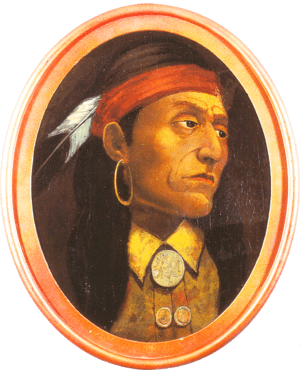Battle of Devil's Hole facts for kids
Quick facts for kids Battle of Devil's Hole |
|||||||
|---|---|---|---|---|---|---|---|
| Part of Pontiac's Rebellion | |||||||
 Chief Pontiac |
|||||||
|
|||||||
| Belligerents | |||||||
| Great Britain | |||||||
| Commanders and leaders | |||||||
| Cornplanter Honayewus Sayenqueraghta |
George Campbell † William Fraser † John Stedman |
||||||
| Strength | |||||||
| 309 | 134 | ||||||
| Casualties and losses | |||||||
| 1 wounded | 81 soldiers and 21 teamsters and escort killed, 1 teamster and 8 soldiers wounded |
||||||
The Battle of Devil's Hole was a fight that happened near Niagara Gorge in what is now New York state. It took place on September 14, 1763. This battle was part of a bigger conflict called Pontiac's Rebellion (1763–1766).
In this battle, about 300 Seneca warriors fought against British soldiers. The Seneca warriors defeated the British, killing 81 soldiers and wounding 8 others. The British had to retreat.
Why the Battle Happened
Even before this battle, as early as 1757, the Seneca people living near Niagara Falls were unhappy. They complained to the French because they were losing control of a long path used to carry goods, called a portage. French traders were trying to make this path better for wagons. The Seneca felt that Europeans were taking over their land and their jobs.
After the Seven Years' War, the British took control of this area near the Great Lakes. A man named John Stedman improved the old portage trail. He made it wide enough for oxen and wagons. He also hired teams and guards to carry goods along the path. Before this, up to 300 Seneca men worked as porters, carrying goods on their backs. They saw this portage as their own.
Many Native American tribes in the Great Lakes area became very unhappy. They wanted to push out the colonists before more of their land was taken. In Pontiac's Rebellion, which started in 1763, several tribes worked together. They formed a large group to fight against British control of the region.
In the New York colony, Sir William Johnson was in charge of Native American affairs. He often spoke up for fair treatment of Native Americans. But he was only partly successful. He once wrote that British people were "ill calculated to maintain friendship with the Indians." He meant they didn't treat Native Americans well in peacetime, even though they feared them in war.
The Battle Itself
On September 14, 1763, a large group of Seneca warriors attacked. There were about 300 to 500 warriors. They ambushed a wagon train and its armed guards. The wagons were traveling from Fort Schlosser to Fort Niagara.
The attack happened in a tough area known as Devil's Hole. Part of the trail went through a heavily wooded area with deep ravines on both sides. This was a perfect spot for an ambush. The Seneca warriors attacked the wagon train there.
The guards and wagon drivers, led by John Stedman, were completely surprised. The animals pulling the wagons panicked and ran. Many wagons and drivers were pushed into the ravines. The Seneca warriors fought very closely, making it hard for the British to use their muskets. Only three people, including Stedman, managed to escape and get help from Fort Schlosser.
Nearby, at Lewiston, a group of British soldiers was camped. These were from the British 80th Regiment of Light Armed Foot. Two companies of these soldiers, led by George Campbell and William Fraser, heard about the ambush. They quickly rushed to rescue the wagon train.
However, about a mile from the wagon train, the Seneca warriors attacked these soldiers too. They were hidden on a brush-covered hill overlooking the trail. When the British soldiers tried to retreat, the Seneca cut them off from the fort. The Seneca killed "more than 80 soldiers." In total, 81 soldiers died and 8 were wounded. Some reports even say the entire rescue party was killed. The Anglo-Americans called this event "The Devil's Hole Massacre." A Seneca warrior named Dekanandi later said that 309 warriors attacked the British. He also said that the Seneca only lost one man who was wounded.
What Happened After
Soon after the second battle, more British soldiers arrived from Fort Schlosser. They were led by Major John Wilkins. But they quickly went back to the fort because they were afraid of another attack.
After the battle, Sir William Johnson was told that a Seneca chief named Farmer's Brother had planned the attack. This chief led a large group that supported Pontiac. Most historians agree that this battle was connected to the larger Pontiac's Rebellion.
The Seneca attacks were successful, but they also caused the British to make their position in Niagara even stronger. This was the opposite of what the Seneca had hoped for. Eventually, Sir William Johnson forced the Seneca to give up land in this area. They had to give up a strip of land one mile wide on each side of the Niagara River. This strip went from Lake Ontario to Lake Erie. It was called the Mile Reserve. They also lost control of the islands upriver of Niagara Falls. This meant the Seneca lost their traditional control of the river and the portage, which were important for travel, food, and water.
The Seneca tried for a long time to get back control of the river banks. White settlers mostly stayed away from the area until after the American Revolutionary War. After that war, many Iroquois, who had been allies of the British, were forced to move to Canada.

